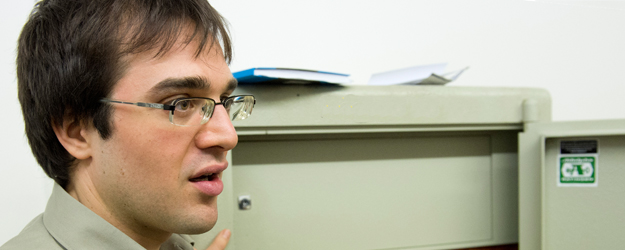18 March 2013
Although the coin collection of the Department of History's Ancient History division at Johannes Gutenberg University Mainz (JGU) fits into a single vault, it still holds quite a few surprises – at least for the layperson. Huge Roman coins sit beside ranks of imperial representations. Alexander the Great and Cleopatra can be admired here in silver, gold, and bronze.
Filippo Carlà lowers any possible expectations: "It is a really small collection," says the Junior Professor of Cultural History of Antiquity as he unlocks the door to a windowless room. Bare tables are visible, there are a few dozen volumes of numismatic literature on the shelves. Two brand-new showcases stand in the background waiting for their plastic wrapping to be removed. "We have just acquired those," says Carlà.
A vault the size of a refrigerator stands against the wall. It contains the entire coin collection of the Ancient History division at the Department of History at Mainz University. Carlà opens the heavy metal door to reveal 20 flat wooden drawers. "We do not have any rare collectibles," he continues modestly. "It is primarily a teaching collection."
Gold, silver, bronze
He grabs a coin. "This is Roman small change." Carlà holds up a bronze disc the size of a child's fist. Like a hump, a Janus head bulges from the front side and on the back there is a ship with a battering ram. The Romans used these giant heavy coins in everyday life, in taverns or at the market.
Gold, silver, or bronze coins were in circulation as currency then. The metal used determined their value. The first mintages from bronze, a non-precious metal, were particularly large and heavy. Silver and later gold coins were lighter and more delicate. "But we only have a few gold coins," explains Carlà. Samples of silver or bronze coins are sufficient for student identification exercises.
The old Mainz University used to have a large coin collection. However, when the university was disbanded at the end of the 18th century, the collection was moved from place to place before ending up in the city archives. When Johannes Gutenberg University Mainz was reopened in 1946, Hans Ulrich Instinsky was appointed as the Chair of Ancient History. His private collection is part of the new collection at the JGU Department of History. Heinz Bellen, his successor, bought Instinsky's coin collection for the institute in 1974. At the time, the collection consisted of 272 coins. It gradually grew with additional purchases and now contains 946 coins.
Gallery of the Roman Empire
"Our focus is on the early Roman Empire," explains Carlà. Most of the coins were minted between 600 B.C. and 600 A.D. However, there are exceptions. Carlà shows a coin from the 16th century from Giovanni Cavino's workshop. The medalist and goldsmith from Padua created new coins by very closely imitating ancient coins. "Such specimens allow us to discover how antiquity was perceived in the Renaissance."
Students do not use the collection just for identification exercises; they also design exhibitions. In 2012, the exhibition "First Ladies – Roman Empresses as Role Models" was on display in the Philosophicum building on the university campus. "It was a great success," Carlà recalls. Amongst other things, the exhibition received a lot of attention in numismatic journals.
The Mainz collection has no great material value. Many of the coins could be bought for just a few euros. "However, we have some that would bring a few thousand euros," says Carlà. And he goes on to explain: "We attach great importance to the collection because it is very important for educational purposes."
Coins in the database
Currently, an electronic database is being created for the Ancient History division's coin collection. Claudine Walther has taken on this responsibility. The student assistant weighs and measures each coin before entering the detailed data into the database. Carlà and Walther are also currently preparing texts for the Internet, as the coin collection will also soon be available online.
It is a pity that the collection usually remains out of sight, for there is much to discover. Each coin tells a story: For example the denarius that Emperor Tiberius ordered to depict his mother Livia as the goddess Salus, the embodiment of health and well-being. Or the solidus of the Emperor Arcadius. "The coin's Christian symbolism makes it typical of Late Antiquity," Carlà explains. Or the bronze coin of Cleopatra from the first century B.C. or the "half siliqua" from Theodoric the Great, an Ostrogothic king from Italy ...
Walther's favorite coin is a tetradrachm from the third century B.C., a silver coin that looks like new. It was minted during the rule of Lysimachos, who was a general under Alexander the Great. It depicts Alexander as the embodiment of the god Zeus Ammon. Ram horns can be seen in his curly hair. What is this coin worth? It doesn't matter; it's beautiful, a treasure.





